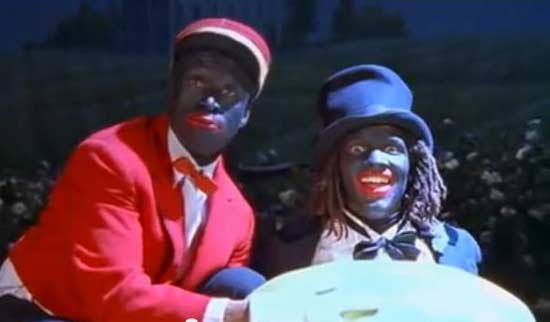Bamboozled
Film Reviewed by Michael Dequina
Bamboozled
Release Date: October 6th, 2000 (LA/NY); October 20th, 2000 (wide/moderate)
MPAA Rating: R (for strong language and some violence)
Distributor: New Line Cinema
Cast: Damon Wayans, Savion Glover (Mantan), Tommy Davidson (Sleep ’n Eat), Jada Pinkett Smith, Michael Rapaport, Charli Baltimore, Canibus, Julie Dretzin (Beth), MC Serch, Mos Def, Gano Grills, Kris Park, David Wain (Bunning)
Director: Spike Lee
 With the NAACP once again criticizing the four major broadcast television networks for the lack of racial diversity—and a limited variety roles for African-Americans—in the new television season, the time is ripe for a film like Bamboozled, which satirizes the TV industry’s arguably racist practices. And who better than Spike Lee to direct such a confrontational film, right? But it’s one thing for a film to wear an agenda on its sleeve, and quite another to do what Lee does here—bludgeon the viewers with his message, preaching to them rather than making them think while entertaining them.
With the NAACP once again criticizing the four major broadcast television networks for the lack of racial diversity—and a limited variety roles for African-Americans—in the new television season, the time is ripe for a film like Bamboozled, which satirizes the TV industry’s arguably racist practices. And who better than Spike Lee to direct such a confrontational film, right? But it’s one thing for a film to wear an agenda on its sleeve, and quite another to do what Lee does here—bludgeon the viewers with his message, preaching to them rather than making them think while entertaining them.
For a little while, though, Lee achieves that balance. A good example is an early scene where Pierre Delacroix (Damon Wayans), the sole black writer for the fictional Continental Network System, is told by the network’s white, ebonics-spouting programming head Dunwitty (Michael Rapaport) that he’s "blacker" than he is. In addition to wringing pointed, biting laughs, this scene also concisely pints up a real issue: the Harvard-educated Pierre wants to create respectable series spotlighting the oft-ignored African-American middle class (think The Cosby Show) while Dunwitty wants to see the slang- and slapstick- heavy sitcoms that are the predominant television showcase for blacks (think Homeboys in Outer Space).
So, in an act of spite, Pierre gives Dunwitty exactly what he wants—to the nth degree: Mantan: The New Millennium Minstrel Show, featuring street performers Manray (Savion Glover) and Womack (Tommy Davidson) in a throwback to the offensive comedy/variety stereotypes of yesteryear. Watermelon patch dwellers "Mantan" and "Sleep ’N Eat" wear burnt cork blackface and get into all sorts of misadventures—always as a direct result of their ignorance and laziness. But every once and a while, Mantan and Sleep ’N Eat break out into spirited song and dance numbers while backed up by their house band, the Alabama Porch Monkeys; and their dance troupe, the Pickaninnys.
The parallel Lee draws between TV (and entertainment in general) of today and yesteryear is clear—blackface aside, the common portrayal of African-Americans on the tube is disconcertingly similar, if not nearly identical. As the film firmly establishes this provocative point through that plot development, it would only follow that Bamboozled would then build into even more incendiary satire. What ignites instead, however, is Lee’s need to vent about a variety of other issues.
Much like how Mantan slips out of control as it becomes an unexpected runaway success, Bamboozled soon flies off the reins. Now a media sensation, Manray indulges in the high life and believes his own hype; similarly, Pierre, who could already be pegged as a sellout with his ridiculously "refined" accent and diction, basks in the attention and accolades for a creation that he designed to die on the vine. Lest one think one of the film’s messages is to "keep it real," the Mau Maus, an afrocentric rap group headed by the brother (Mos Def) of Pierre’s assistant Sloan (an impressive Jada Pinkett-Smith), is similarly raked over the coals and then some; for all their talk of revolution and staying true to their roots (for example, Sloan’s brother changed his name from Julian to Big Black Africa), they spend most of their time guzzling forties and smoking weed.
Despite the muddiness caused by all the peripheral concerns, Lee never makes one forget that Bamboozled is, foremost, an attack on racial misrepresentation in entertainment. It’s impossible to sight of that, given how increasingly heavy handed his technique gets as the film wears on, crossing the line between satire and sermon; sly, stinging wit makes way for earnest and overblown preachiness—as exemplified by a lengthy montage of racist images in entertainment through the years that comes late in the film.
Amplifying the sense of bombast is a violent, melodramatic wrap-up—which, in itself, reinforces another stereotype: that African-American-themed films end with some type of bloodshed. Is this another point on Lee’s list or an unfortunate coincidence? With the bungle that is Bamboozled, anyone’s guess is as good as mine.

Read More AALBC.com Film Reviews
